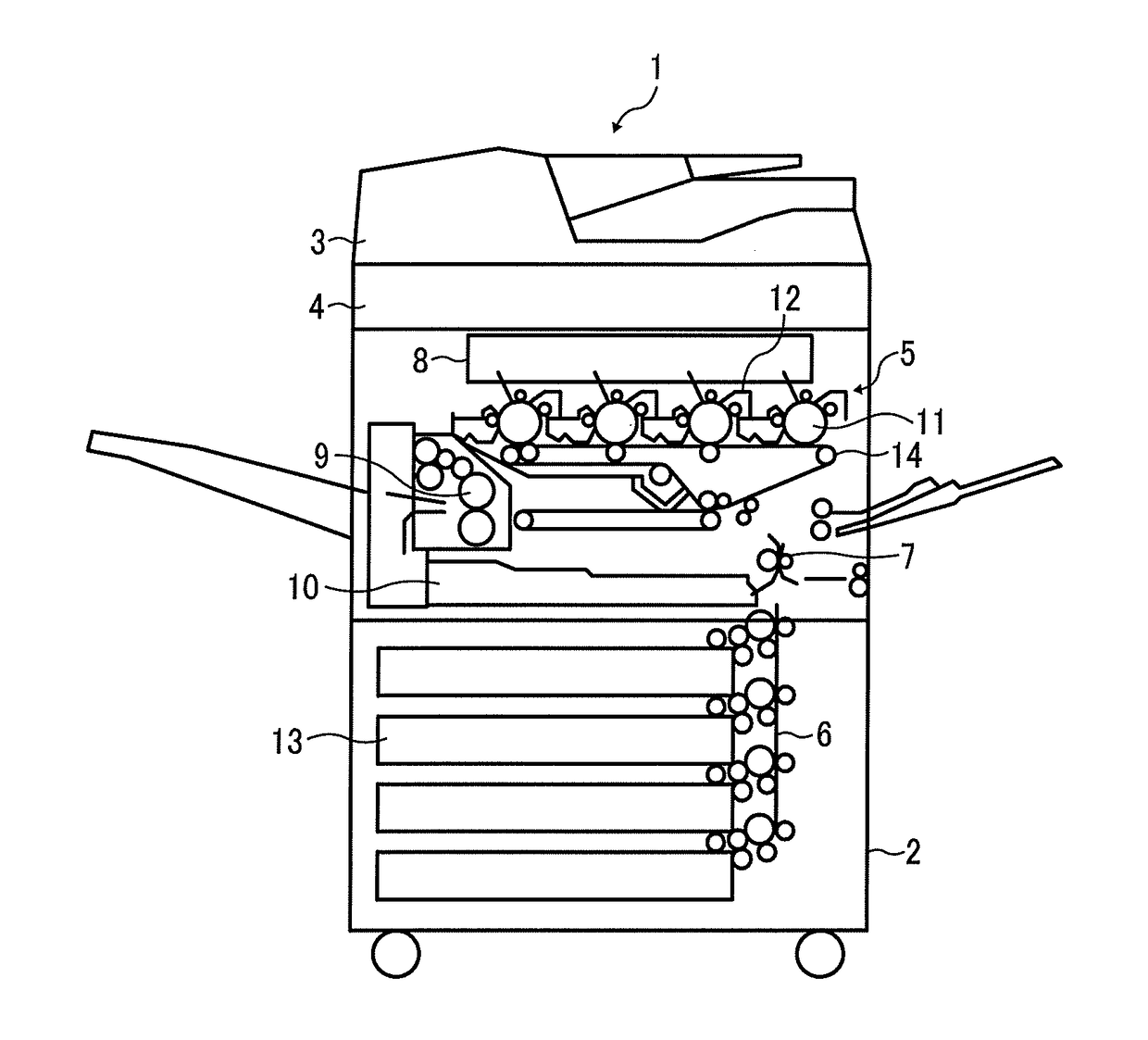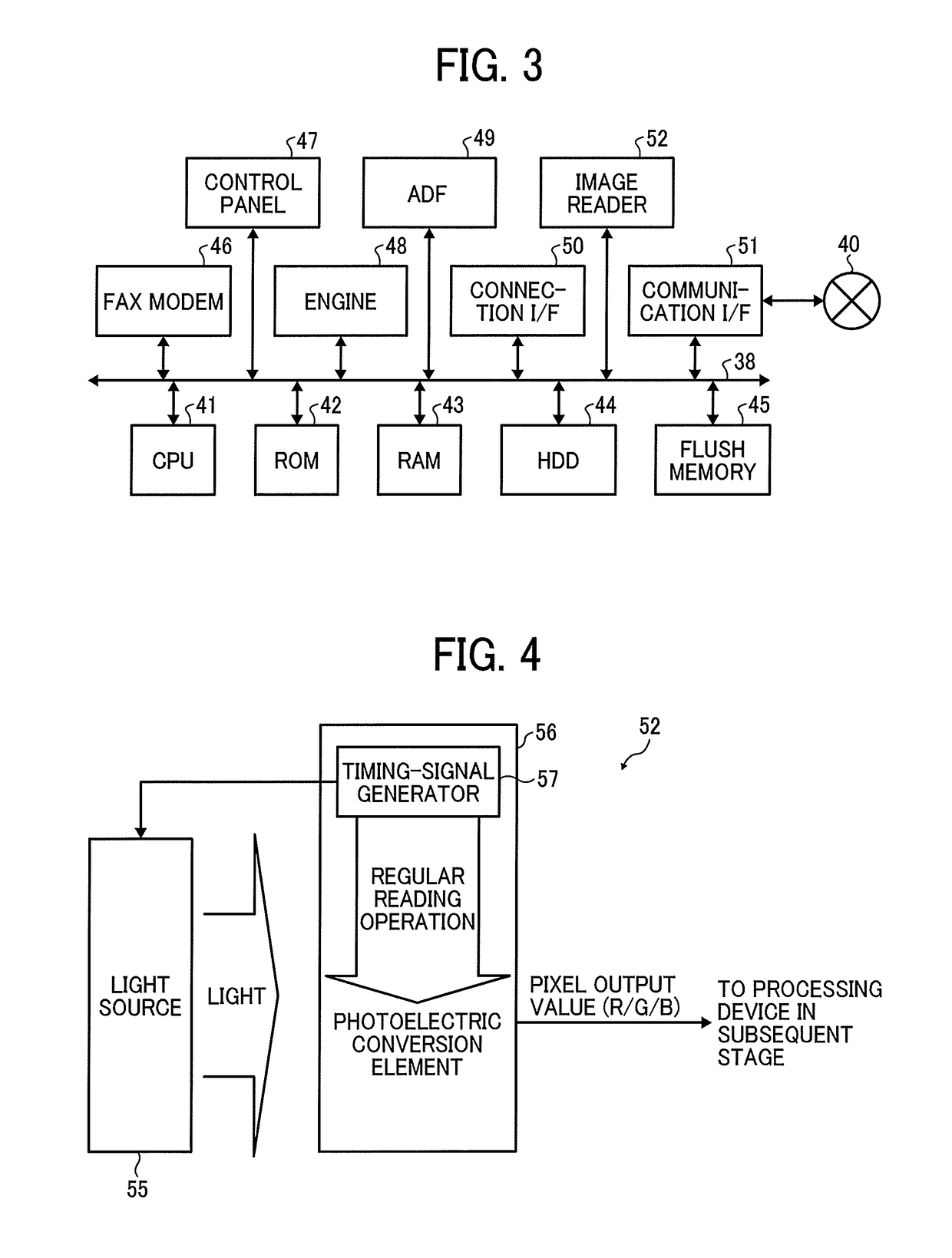Photoelectric conversion device, photoelectric conversion method, and image forming apparatus
a photoelectric conversion and conversion method technology, applied in the direction of electrical devices, diodes, radiation controlled devices, etc., can solve the problems of increase the adverse effect of rts noise, so as to improve the photoelectric conversion method
- Summary
- Abstract
- Description
- Claims
- Application Information
AI Technical Summary
Benefits of technology
Problems solved by technology
Method used
Image
Examples
first embodiment
[0082]The MFP according to the first embodiment includes a noise detector 71, a memory 72, and a pixel corrector 73 disposed at the subsequent stage of the photoelectric conversion element 56 as illustrated in FIG. 13. The noise detector 71 detects a physical address of a pixel (the pixel-signal generation circuit 61 for a pixel) that generates noise in the photoelectric conversion element 56. The memory 72 stores address data regarding the pixel from which noise has been detected. The pixel corrector 73 performs correction processing on the pixel from which noise has been detected.
[0083]Note that some or all of the photoelectric conversion element 56, the noise detector 71, the memory 72, and the pixel corrector 73 are integrated as a single circuit. In the example of FIG. 13, the photoelectric conversion element 56, the noise detector 71, the memory 72, and the pixel corrector 73 are sealed in a package to be apparently a large-scale integration circuit (LSI), that is, formed as a...
second embodiment
[0093]Next, a description is given of a MFP according to the second embodiment. The above-described pseudo light shielding mode is a mode to output a reset electrical potential and obtain data (dark-time image signal) that is equivalent to the image signal of dark-time data obtained with light shielded. The MFP according to the second embodiment obtains such a dark-time image signal in the following manner.
[0094]FIG. 17 illustrates timing charts of signals of the components (see FIG. 6) of the photoelectric conversion element 56 in the MFP according to the second embodiment in the pseudo light shielding mode. Same as FIG. 15, FIG. 17(a) is a timing chart of a line synchronous signal (Lsync) for one line. FIG. 17(b) is a timing chart of a switch control signal (SL) to on-off control the switch SL. FIG. 17(c) is a timing chart of a reset signal (RT) to on-off control the reset switch RT to reset the electrical potential in the floating diffusion FD to a rest electrical potential AVDD_...
third embodiment
[0097]Hereinafter, a description is given of a MFP according to a third embodiment of the present disclosure. FIG. 18 illustrates timing charts of signals of the components (see FIG. 6) of the photoelectric conversion element 56 in the MFP according to the third embodiment in the pseudo light shielding mode. Same as FIG. 17, FIG. 18(a) is a timing chart of a line synchronous signal (Lsync) for one line. FIG. 18(b) is a timing chart of a switch control signal (SL) to on-off control the switch SL. FIG. 18(c) is a timing chart of a reset signal (RT) to on-off control the reset switch RT to reset the electrical potential in the floating diffusion FD to a rest electrical potential AVDD_RT. FIG. 18(d) is a timing chart of a transfer control signal (TX) to on-off control the charge-transfer switch TX to transfer charges accumulated in the photodiode PD to the floating diffusion FD. FIG. 18(e) is an illustration of the timing and level of the image signal (Pix_out) output from the pixel-sig...
PUM
 Login to View More
Login to View More Abstract
Description
Claims
Application Information
 Login to View More
Login to View More - R&D
- Intellectual Property
- Life Sciences
- Materials
- Tech Scout
- Unparalleled Data Quality
- Higher Quality Content
- 60% Fewer Hallucinations
Browse by: Latest US Patents, China's latest patents, Technical Efficacy Thesaurus, Application Domain, Technology Topic, Popular Technical Reports.
© 2025 PatSnap. All rights reserved.Legal|Privacy policy|Modern Slavery Act Transparency Statement|Sitemap|About US| Contact US: help@patsnap.com



